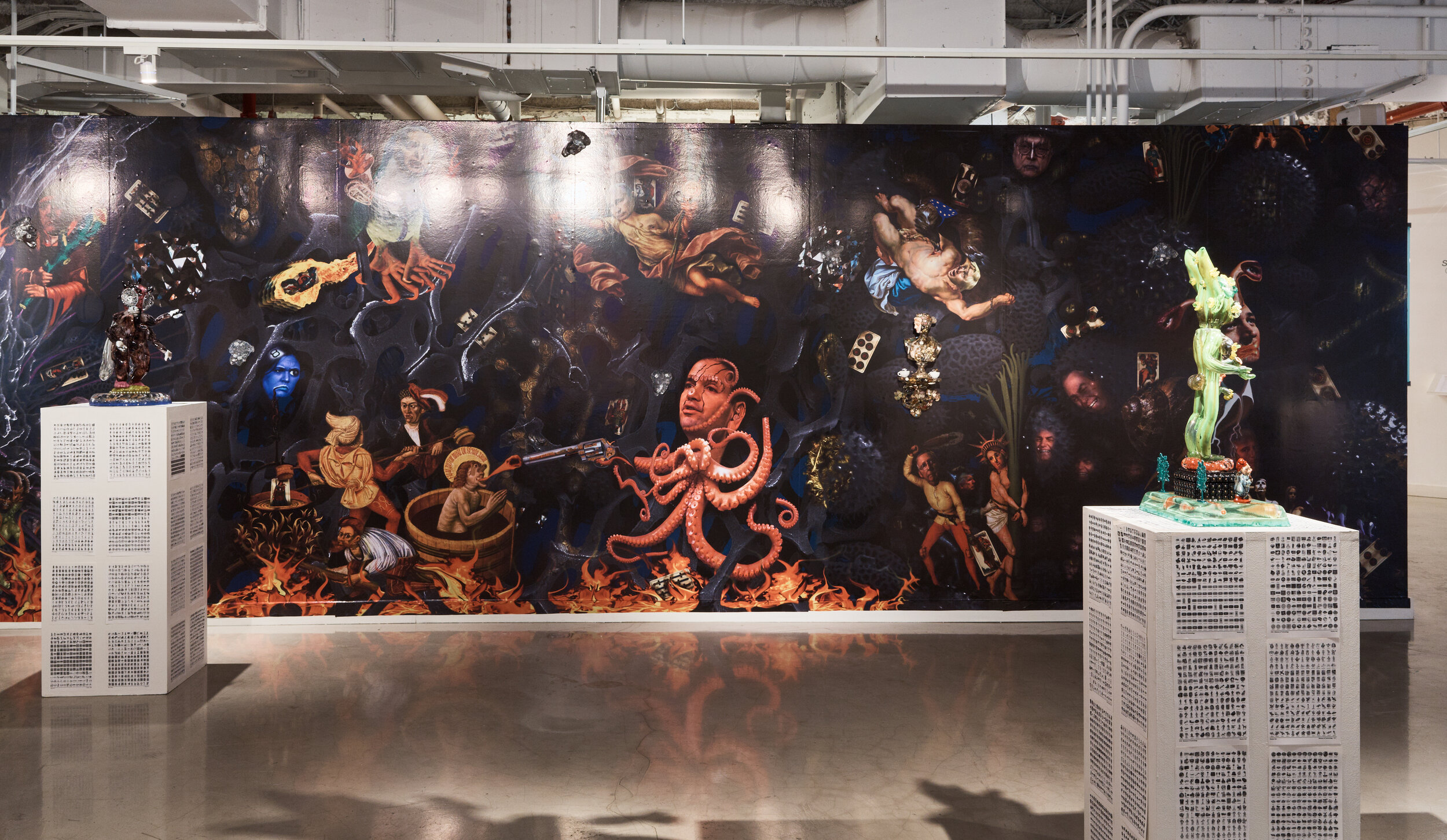When consuming the work of the De La Torre Brothers one is well served to ponder the unusual fraternal wellspring from which this richly dripping trans-cultural aesthetic and sharp societal critique flows. Two distinct yet symbiotic brains speak in the overlapping visual languages of a mashed up cultural construction. Like a co-joined fascination at the freak show, their four hands pass ideas and materials lovingly and mercilessly back and forth to amplify the excess until it vibrates just right. When the collaboration is complete, it is irrelevant where one brother’s influence ends and the other’s inspiration begins. The pervasive themes of duality, tragic humor, double image and contradiction present a conversation interrupted that defies our desire for simple conclusions.
In 1998, the brothers produced a show at UrbanGlass titled 11:58 PMAD that presented a dystopian view of the approaching turn of the century. In a country under the incompetent rule of a benevolently evil W and gripped by the irrational fear of a flipping decimal few could imagine a future more dire. The brothers could and did. With their usual fatalistic humor, they kept us laughing to satisfy our need to cry.
Now twenty years into the 21st century “High Noon” displays the prescience of that dark vision. We now find ourselves floundering in the “pastopian” responsibility of an Anthropocene reality where we clumsily juggle the fate of our planet with every lurch towards global meltdown. We look to our mad amoral berserker in chief, glowing bright orange atop his glistening pile of big macs, and miraculously summon nostalgia for the bumbling of our simpler past.
Through the optical magic of luscious lenticular images and super saturated three-dimensional wallpaper the artists have invited our modern-day Boschian beasts to romp around in a hyper-sensory garden of earthly delights. Our wits are subjected to a state of psychedelic overload that draws us deeply into endless layers of excess and macabre opulence. The archeological layering of ubiquitous digital emoji over an ancient mandala made of disposable dollar store bling serves to remind us of the timeless nature of these struggles.
By straddling borders and cultures and borrowing freely from the languages and symbols they encounter on their endless global travels the brothers are able to vacillate between critical outsiders and enthusiastic appropriators. The resulting mashup is both utterly specific to time and place and universally approachable and digestible. The carefully bilitterate text that the artists offer up in titles and embedded in the work are Easter eggs planted in plain sight to assist in the unpacking of these visually and conceptually dense offerings. The brothers are cunning linguists and never miss an opportunity for word play, often combining dialects to create double entendre and inject a kick in the gut sense of humor to the dialog.
As tireless educators and prodigious and highly visibly creators, Einar and Jamex have long flown the flag for the freak contingent of the glass community. Through direct mentorship and as reluctant role models the brothers have influenced a generation of artists to abandon the precious and stale stereotypes of how and for what glass should be used. By breaking free of these tropes, they have lead the way towards a weirder, more wondrous future for the field.
With “High Noon”, the two-headed de la serpent gnaws at the Achilles heel of a dying culture yet feeds to us the beautiful crinkly skins of our serpentine rebirth. The message is clear: something is definitely rotten in the state of our state. Awash in their hyper reality we are presented with the distinct possibility that it may have to all burn to the ground on our path to reincarnation. Though cynically pessimistic about our current state of affairs, there still lingers the slightest whiff of ironic hope that our salvation may still rest amidst our rush to self-destruction.














